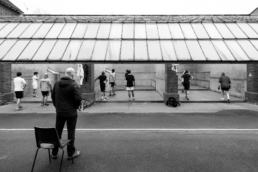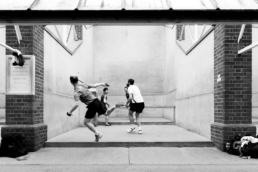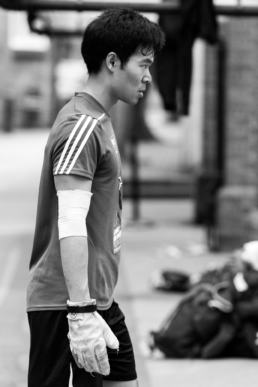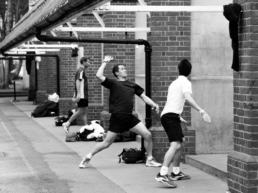This article original appeared on BlackBLK magazine. Head there for a broader selection of images.
Eton Fives is a handball game developed in the late 19th century at Eton College. It is an uncommon sport, with a large number of unique rules, as unique stands the shape of the court: it consists of three walls, with the left hand wall interrupted by a buttress approximately halfway up the court, resembling one of the bays at College Chapel where the game was invented.
Only a few courts do exit, most of them as part of the facilities of the public schools in the United Kingdom; outside Britain, the game flourishes in the northern states of Nigeria where more courts are being built every year. You can also find Eton Fives courts at Geelong Grammar School in Australia; a few in Switzerland; at St. Paul’s School Darjeeling, India; and at Malay College Kuala Kangsar, Malaysia.
In 1840, the Headmaster of Eton, Dr Hawtrey, built the first block of four Eton Fives courts along the Eton Wick road. The design of these was based on, but was not an exact replica of, the chapel court. In 1877 AC Ainger, with several friends, drew up and published the Rules of the Game of Fives as played at Eton. In the following years, minor changes were made to these rules.
Fives has many rules that are similar to other court type games, such as tennis or squash: for example, the ball is only allowed to hit the floor once, and the pair whose turn it is to hit the ball up must do so without the ball hitting the ground. But there are a large number of rules unique to the game of Eton Fives: for example, all games are played to 12; however, if the score is 10–10, or 11–11 the game can be ‘set’ and played to a higher number. Also, when a pair reaches 11 points, the server must stand with at least one foot on the bottom step when they serve; from that point they cannot move until the ‘cutter’ has hit to ball.
There are now a huge number of championships that take place at various times and places. The history of one of the most important tournament in Eton Five starts back in 1924, when Lord Kinnaird gave a challenge cup to be competed for by pairs from the Old Boys clubs and in 1931 the title was changed to the Amateur Championship for the Kinnaird Cup.
The Kinnaird Cup, held annually in Eton, is now an open tournament for men of any age. Over the years it has become more and more competitive, and is now the most sought after trophy of them all. In 2017 edition, shown in pictures here, Seb Cooley and Tom Dunbar continued their recent dominance of the Kinnaird Cup and maintained their remarkable unbeaten record.












